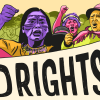Protecting people’s land rights is also about measuring them in the right way. The upcoming Sustainable Development Goals are a historic opportunity to improve the livelihoods of the most marginalized women and men in the world. To do this, we need indicators that do not go below existing international benchmarks that protect people’s land rights. The problem is that we are not yet there.
A few weeks ago I was in New York for the intergovernmental negotiations around the Sustainable Development Goals (SDGs) that will be agreed in September 2015. Over the last few months, governments, UN agencies and civil society have been busy discussing what sustainable development means, and what the world should do to eradicate poverty and achieve a better life for all, whilst protecting the planet.
In particular, I was in New York to monitor the extent to which secure and equitable land rights are part of this framework. This matters to Oxfam because, in most countries of the world, land rights are what make the difference for women and men living in poverty. They empower people. They make women’s voices stronger when decisions are taken and communities more able to resist land grabs. They give more chances to be food secure and have a secure income, and provide an incentive to care about the environment.
There is a strong consensus on this subject, signified by several intergovernmental agreements and declarations, like the UN Declaration on the Rights of Indigenous Peoples (2007), the African Union Framework and Guidelines on Land Policy (2010), and the Voluntary Guidelines on the Responsible Governance of Tenure (2012).
The question we are now facing is simple: are the Sustainable Development Goals matching these international standards on land rights? And the answer is: not yet.
And it is (almost) all about indicators.
Governments have included “access” to land under three Goals, namely Poverty Eradication (1.4), Food Security (2.3) and Gender Equality (5.a). The language is not perfect, but the recommendations are strong. Governments are now discussing the indicators that will be used to track progress on these targets. This is a technical exercise, and here it is not acceptable to go below the lines set by international standards.
Indicators seem like quite boring stuff. In reality, they are a fundamental piece of the upcoming Post-2015 Agenda, because they will tell us in a very concrete way how well or badly we are implementing agreed targets.
Oxfam has been working extensively on this for the last two years, and identified some criteria to judge if an indicator is good or not. Land rights indicators must:
- disaggregate data by women and men (see a good blog post on this), urban and rural;
- track progress on the full range of individual and community-based tenure systems, including over common lands (see another good blog post here);
- track progress on outcomes, and not just laws;
- capture perceptions of tenure security to understand who has actual control over the land.
The UN Statistical Commission (UNSC) is leading this discussion, and it is fair to say that they have a tough job to do. Earlier in March, they prepared a preliminary list of indicators, and included a land rights indicator to track progress on poverty eradication and gender equality.
This is good news of course. But it is not enough.
The big problem is that this indicator does not track progress (or failures) in securing Indigenous Peoples and local communities’ tenure over common lands, leaving behind those whose livelihoods depend on forests, wetlands, drylands, or rangelands.
This not only reduces policy-makers’ ability to take informed decisions, but will actually help them to make bad decisions. The risk is that countries’ performance will be assessed solely on the basis of individual land titling, setting up a perverse incentive that promotes fragmentation of common lands, making communities more vulnerable to food insecurity and human rights violations, and our planet more prone to biodiversity loss.
In other words, the indicator currently on the table does not match international standards.
What is not counted is not protected. In the case of common lands, we would be missing a tenure arrangement that sustains the livelihoods of up to 2.5 billion people, governing at least 6.8 billion hectares of land around the world, often on the frontline of our fight against climate change. To be more specific, forests and other ecosystems under commons provide between 47-89% of the so-called GDP of people living in poverty. Grazing lands alone sequester between 1-2.5 * 1012kg of carbon every year.
Oxfam, together with several other organizations, has prepared a technical briefto help policy makers in making land rights indicators for the SDGs more consistent with international agreements, supporting proposals made by the Sustainable Development Solutions Network and UNEP, which are also consistent with the work of the influential Global Land Indicator Initiative.
We have the historic opportunity to make choices that will improve the livelihoods of the most marginalized women and men in the world.
We can do it. We just have just to align the SDGs to existing international benchmarks governments have already signed. Will we?
By Luca Miggiano


